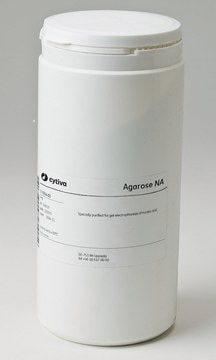A4018
Agarose, low gelling temperature
Synonim(y):
2-Hydroxyethyl agarose
About This Item
Polecane produkty
pochodzenie biologiczne
algae (marine)
Poziom jakości
Postać
powder
metody
cell culture | mammalian: suitable
EEO
≤0.10
temp. przejścia
congealing temperature 26-30 °C
siła żelu
≥200 g/cm2 (1% gel)
Szukasz podobnych produktów? Odwiedź Przewodnik dotyczący porównywania produktów
Opis ogólny
Zastosowanie
Agarose, low gelling temperature has been used:
- to immobilize zebra fish embryos during in vivo imaging experiments
- as a constituent of defined medium to culture bovine nucleus pulposus (NP) cells
- as a hydrogel, a scaffolding material for dental pulp regeneration
- in the form of pellets to determine the surface pH and conductivity of an acrylic emulsion film
Jakość
Komentarz do analizy
Sulfate content - used as an indicator of purity, since sulfate is the major ionic group present.
Gel strength - the force that must be applied to a gel to cause it to fracture.
Gel point - the temperature at which an aqueous agarose solution forms a gel as it cools. Agarose solutions exhibit hysteresis in the liquid-to-gel transition - that is, their gel point is not the same as their melting temperature.
Electroendosmosis (EEO) - a movement of liquid through the gel. Anionic groups in an agarose gel are affixed to the matrix and cannot move, but dissociable counter cations can migrate toward the cathode in the matrix, giving rise to EEO. Since electrophoretic movement of biopolymers is usually toward the anode, EEO can disrupt separations because of internal convection.
Kod klasy składowania
11 - Combustible Solids
Klasa zagrożenia wodnego (WGK)
WGK 3
Temperatura zapłonu (°F)
Not applicable
Temperatura zapłonu (°C)
Not applicable
Środki ochrony indywidualnej
Eyeshields, Gloves, type N95 (US)
Choose from one of the most recent versions:
Certyfikaty analizy (CoA)
Don't see the Right Version?
If you require a particular version, you can look up a specific certificate by the Lot or Batch number.
Masz już ten produkt?
Dokumenty związane z niedawno zakupionymi produktami zostały zamieszczone w Bibliotece dokumentów.
Klienci oglądali również te produkty
Nasz zespół naukowców ma doświadczenie we wszystkich obszarach badań, w tym w naukach przyrodniczych, materiałoznawstwie, syntezie chemicznej, chromatografii, analityce i wielu innych dziedzinach.
Skontaktuj się z zespołem ds. pomocy technicznej



